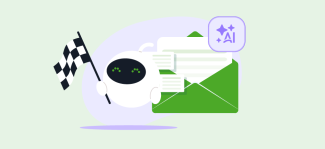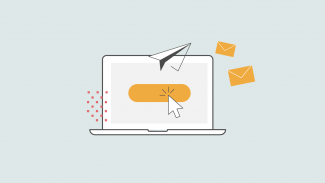Email List Consent Is Sexy!
When compared to all the heavy lifting advertisers had to do to reach audiences some two decades ago, modern email marketing feels like the lottery.
Pretty much all you have to do is compose an email and then hit the ‘send’ button. The reach is unlimited; conversion rates are decent, and — wait for it — it costs next to nothing.
But it's not all breezy. For email marketing campaigns to succeed, you’ll need high engagement rates — in terms of opens and click-through rates from your subscribers. And to keep the subscribers on your list engaged, loyal, and making purchases, there are some rules to follow.
For one, the quality of your emails faces an inevitable decline. Even if you're diligent about keeping it updated and clean, you'll still see a downturn in its accuracy.
As your contacts switch roles across companies, their email addresses are bound to change. And since not all subscribers will become an eventual customer, others will opt-out of your email communication. This is why you need to constantly update your lists with high-value contacts who have indicated some sort of interest in your offering.
Staying on track as far as building out your email list is concerned involves a tidy mix of strategy, email list hygiene, best practices, and do’s and don’ts.In this post, we’re happy to roll out insight into what a winning strategy entails — one that gets you a high-quality pool of email subscribers.
But first, it's worth going over some do’s and don’ts:
Dos
Always obtain consent with double opt-in features.
Within the EU, every email marketer knows the GDPR and the changes it has inspired since it came into effect in 2015. One of the biggest requirements it has imposed on email marketers is obtaining consent from subscribers before putting them on their email lists.
While it might seem a hassle, your strategy will be the better for it — you’re dropping half-interested and uninterested contacts like a hot potato!
How?
With double opt-in features, subscribers first have to input their email addresses on your website or wherever else they found the invite, after which they proceed to give further consent (if interested) when they receive a confirmation email.
By giving subscribers the opportunity to confirm that they issued their consent to opt-in to your communications, you’re making sure that only subscribers who want to receive your messages sign up. These high-quality leads are more open to purchases and responsive to upselling or cross-selling efforts since it takes more than 1 click to get on the list.
Additionally, no one likes being spammed.When too many subscribers send your emails directly to the spam folder, you could get blacklisted by email service providers. Obtaining consent with double opt-in helps you verify that it’s the same individual who issued consent that owns the email address.
Apsis double opt-in capabilities comes with an Email Editor that features customisable templates. Your email and confirmation page design plays a huge role in hinting to your contacts that the confirmation email is from you. You can customise these templates in line with your brand guidelines.
Regularly delete dormant subscribers
Even after you have obtained double opt-in from your subscribers, you must monitor engagement rates constantly to identify dormant subscribers.For one, sending emails directly to contacts with an inactive inbox or address can lead to being blacklisted. You can also get blacklisted if your emails received a high number of spam complaints.
Besides, it's not exactly cost-effective to spend money sending emails to email accounts that are no longer in use. When a subscriber hasn’t opened your emails in a while, send them a mail to notify them, or offer them some incentives to nudge them to re-engage. And if they don’t, you can take them off the list.
Segment your email subscribers
Since people respond better to marketing messages targeted at them, segmentation will help you to gain higher engagement and conversion rates than you normally would with un-segmented advertising.By sending the right message to the right people at the right time, you can get higher open rates, click-through rates, and conversions.
One of the best ways to segment your email list is by using tags.Tags allow you to categorise your subscribers based on their interests, behaviour, or any other criteria. This way, you can send them more targeted and relevant messages that are likely to convert.
One way Apsis helps you harness segmentation is through our row segmentation feature which allows you to create different versions of a single email to be sent to multiple groups of audiences. By including and excluding segments, and building content tailored to each of them, different contacts will receive targeted email messages that speak to their needs, is more relevant, and increases conversion rate.
Finally, you can also segment your email list manually by creating different groups or lists based on specific criteria. For example, you could create a list of subscribers who live in the same country, or who have made a purchase from you in the past six months.
Be Patient
Losing subscribers? Don’t throw in the towel just yet. Much like customers, email subscribers come and go. Admittedly, building and managing a highly profitable email list involves twists and turns that could span a long period.
Also, ‘unsubscribe’, and low engagement metrics come with the territory; we all sometimes want to trim down the amount of emails we receive daily. And while this can sometimes be unnerving, it pretty much lays the groundwork for a successful strategy.
To be fair, unsubscriptions improve the quality of your list. Since people are likely to unsubscribe rather than report your email as spam, it can prevent you from being blacklisted. A high ‘unsubscribe’ rate also helps you find out what content is performing well and which one doesn’t resonate with your contact.
Through all of these, you just have to be patient, positive, and clear-eyed about your strategy while adapting to situational changes where necessary. One thing you constantly have to keep an eye out for, though, is an overwhelming amount of subscribers, which can be indicative of a weakness in your strategy.
• Always reach out as soon as possible
You must reach out to subscribers as soon as possible after they sign up on your list. If you reach out too late, it’s possible that they might have lost track of the interest and curiosity that got them to subscribe in the first place.
A modern digital marketing solution like Apsis solves this problem with tools that allow you to build and send automated but personalised welcome emails after your contacts have confirmed their subscription.
Dont’s
Buying email lists? Perish the idea
If you think purchasing email subscribers is the way to go, you might want to think again. Besides the possibility that you may be violating data privacy laws (think GDPR), you risk being perceived to be another internet marketing robot — not the best impression to make to your contact.
Admittedly, the GDPR hasn't made purchasing email lists outright illegal. However, it's just not advisable. Here’s why: the GDPR mandates that you obtain explicit consent from individuals before emailing.
Often, purchased contacts do not consent to the purchaser contacting them. As such, you would be violating the GDPR if you did so. That you bought the data from a reputable company may not avail you — you still need to make vital checks before emailing these purchased contacts on your list.
Ultimately, you would be doing your strategy a world of good if you organically compiled an email list where each subscriber opted to be in it.
Let’s face it — not many people respond favourably to suddenly receiving emails from a sender that they never subscribed to. Plus, many of the emails on for-sale lists tend to be of low quality. If you could buy it, imagine that other marketers could as well. And people can only be subject to an unending flurry of marketing emails from strange senders before reporting your emails as spam or unsubscribing.
Besides, many email service providers do not allow the use of bought email lists; it is one of the fastest ways to get blacklisted.
Never send low-quality content
There is hardly a faster way to get your subscribers to hit the unsubscribe button than by inundating them with low-quality content. When people sign up for email lists, they know that they will receive advertising messages. Make it relevant and worth their read, attention, and their time.
So, instead of putting together a collage of ad banners, fill your emails with as much high-quality content as possible. Nothing puts people at ease better than information that they find helpful. This way, subscribers that eventually get to the ads will be more amenable to your calls to action.
Best practices for building an email list
Deploy lead magnets
If you want to grow your email list quickly, a sure way to boost your chances of getting opt-in contacts will be to offer something of value. It could be a free ebook, an exclusive discount, or access to valuable content that they can’t get anywhere else.
Whatever it is, make sure it’s something that will incentivise people to sign up for your list. Once you have your offer in place, promote it heavily on your website and across all of your social media channels. Make it easy for people to find and make sure they know exactly what they’ll be getting in return for signing up.
It’s also human nature to respond positively to incentives. They don’t have to be anything outrightly pricey. But, just by giving out low-cost freebies like early access to new launches, free shipping, and bonus points, you can excite your subscribers into feeling special; and thus drive up engagement metrics.
The first thing you'll need to do is create the lead magnet itself. With your lead magnet at the ready, the next step is to add it to your website through a form that visitors can fill out in order to download your lead magnet.
Beyond the few tips we’ve listed in this article, there’re many other strategies you must consider if you want to build successful email campaigns. We explore everything and more in our latest 120-page handbook, available for free here. Download our complete guide to Email Marketing today.
Use clear exit buttons
No one wants to haemorrhage subscribers. But you know what’s worse? Wasting effort on people who care less for what you have to offer — and wouldn’t even open your emails. For a successful email marketing campaign, your mailing list needs as low a percentage of uninterested subscribers as possible.
Because, even when they are not making purchases, subscribers constantly give vital feedback that you can use to improve your products and strategies. Filling your audience with uninterested people will only muddle up this feedback loop. So, always make it clear that they have the option to unsubscribe. The GDPR also mandates you to place this button somewhere they can easily locate and access it.
Test, test, test
Always test your emails before you send them out to a wider audience. This includes testing things like subject lines, layout, and content to see what works best. You can use tools like A/B testing to help you with this.
Additionally, make sure to proofread your emails before sending them out. This will help ensure that there are no typos or grammatical errors.
Encourage Replies
Email communication is a two-way street. You want your recipients to reply to your emails, right? So make it easy for them.
Email addresses like donotreply@yourcompany.com put off any initial excitement from your potential readers when they open your email. This is especially true for small businesses as it gives the reader the feeling that you really don’t care what they think, or worse, that you are a faceless business that only cares about selling them something.
Instead, use an email address that will encourage replies, such as info@yourcompany.com or contactus@yourcompany.com. This simple change will make a big impression on your readers and could result in more two-way communication.
Wrap Up
Email marketing is one of the most powerful tools that any digital marketer can have.
But there are no shortcuts to building an email list — you have to put in the work. But when it all comes together, a high-quality email list makes your marketing campaigns work like a well-oiled machine, bringing you conversions at a minimal cost. Once you can adhere to the dos and don’ts listed above, you can expect to start seeing results quickly.
Prefer seeing it in action?
Let us show you how our digital marketing solution can help you gather opt-in contacts in a GDPR-friendly way while you focus on building connections through personalised emails and automated campaigns.
Book a demo today!


